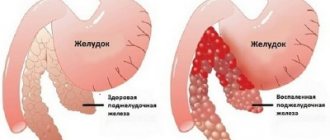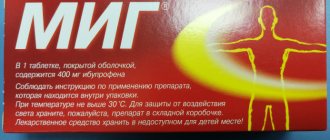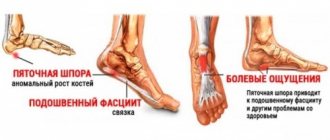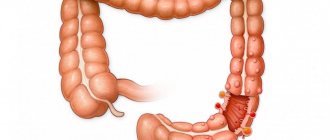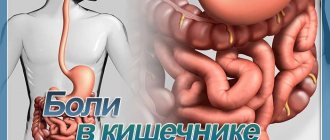Appendicitis is an inflammation of the appendage that comes out of the large intestine. The disease occurs as a result of infection, mechanical blockage of the lumen, and disruption of local circulation. For these reasons, spasm occurs, compression of the appendix with subsequent inflammation. If the destructive process is left unattended, the disease can be complicated by gangrene, blood poisoning, and peritonitis. The organ has a movable fixation. There are several options for its location relative to the rectum. Because of this feature, it is very difficult to determine appendicitis without consulting a doctor and distinguish it from other diseases.
Symptoms
Sudden abdominal discomfort is often associated with eating low-quality products and heavy foods. An attack indicating inflammation of an organ has characteristic manifestations that should alert you.
Appendicitis can be identified by the following signs:
- Severe pain without clear “borders”. It is spread “all over the abdomen” or begins from the upper parts of the peritoneum. Soon the unpleasant sensations descend to the navel area. After a few hours, with the classic (descending) location of the process, cutting sensations are concentrated in the right side. Discomfort increases during movements, coughing, bending and other actions that cause abdominal tension. The sharp pain makes it difficult to take a deep breath.
- The abdomen is swollen with gas. The work of the intestines is difficult due to the inflamed appendix. Gases are retained and difficult to pass. This feature distinguishes appendicitis from other pathologies.
- Adopt a posture that relieves discomfort. Relief comes when a person rests, knees pressed to his chest. Lying on the right side hurts. By this sign, you can understand that appendicitis is developing. When a person turns over to his left side, the pain subsides.
- Nausea and bouts of vomiting. Inflammation causes intoxication by pathogenic bacteria. In adults, abdominal cramps are combined with slight nausea. Children often experience repeated vomiting during an attack.
- Temperature increase. The sign is not characteristic, but always indicates an inflammatory process in the body. After the onset of colic in the right side, the temperature in adults rises to 37.5-38 degrees. When catarrhal (superficial) inflammation develops into complicated (destructive) forms, the pain goes away. This is an alarming sign that determines the death of the nervous system with subsequent destruction of the organ. The temperature after a temporary subsidence of pain can rise to 40°C.
- Intestinal disorders. In adults with an atypical location of the appendix, false urges to “go to the toilet” often occur. Inflammation disrupts intestinal function. The organ cannot digest food normally, resulting in constipation or diarrhea. You can find out that diarrhea is associated specifically with appendicitis by observing the nature of the pain. If a person does not feel relief after defecation, an inflammatory process develops in the intestines.
- Dry mouth. This symptom appears 2-3 hours after the onset of pain. On the second day, the tongue is covered with a white coating.
The first signs that indicate appendicitis are sudden, widespread pain and a tense abdomen.
The main signs of appendicitis
The main symptom of the disease is pain, and more often than not it is this reason that becomes the reason for contacting a doctor. Pain in the abdominal area may not always indicate inflammation, but appendicitis often occurs initially with unclear localization of pain, and gradually aggravation is felt in the lower part of the peritoneum. The person feels discomfort, gradually turning into increasing nagging pain in the iliac region. He may experience lethargy, weakness, and fever. General malaise is often accompanied by vomiting, which is inconsistent.
Features of symptoms
Manifestations of the disease differ depending on the age and gender of the patient.
Children
The baby's body reacts sharply to any irritants. The temperature with appendicitis in preschool children can rise to 40°C. Inflammation in a child is often accompanied by cold symptoms: runny nose, cough, sore throat. Against the background of appendicitis with a high temperature, the immune system is weakened, and other infections are easily associated.
Abdominal pain in children is often accompanied by a sharp increase in temperature, nausea, and repeated vomiting. Such symptoms occur immediately after the appearance of discomfort in the abdominal cavity. If the appendix descends into the pelvis, the baby complains of difficulty urinating.
School-age children sometimes hide symptoms indicating appendicitis because... they become afraid of surgery.
Women
The growing uterus “shifts” the appendix. During pregnancy, closer to childbirth, the organ moves above its normal location, which changes the typical symptoms. To identify acute appendicitis, you need to take into account the first signs. An attack in pregnant women begins with pain under the right rib, near the navel. Then the sharp pains move to the right iliac region. In addition to pain, the woman notices a lack of appetite, pale skin, and weakness. The temperature rises slightly, sweating increases, and the pulse quickens.
In women (difference from male anatomy), the genitourinary system is in direct contact with the digestive organs. Unrecognized inflammation in the uterus and its appendages and ovaries often provokes inflammation of the appendix.
Women may confuse appendicitis with gynecological diseases or menstrual pain. Signs resemble twisting of the cyst, rupture of the ovaries. The difference is that gynecological diseases in women occur without vomiting and painful nausea. Only by this sign can appendicitis be identified and distinguished from diseases of the genitourinary system.
Men
Boys get sick more often than girls. In adulthood, when the appendix is less mobile, the picture completely changes. In men, due to the separation of the reproductive system from the gastrointestinal tract, the risk of the disease is significantly reduced. The symptoms of appendicitis are typical in most cases: the attack begins with diffuse pain. A few hours later the man feels pain in his right side. If the appendage is abnormally positioned, the pain radiates to the back, lower back, and pubis.
Aged people
After 60 years of age, recognizing appendicitis is more difficult than in childhood, young and middle age. This is due to a decrease in the threshold of pain sensitivity, as well as anatomical changes. A characteristic feature by which appendicitis can be accurately identified is moderate pain with swelling and redness on the skin in the lower abdomen.
Stool retention does not play a special role in home diagnostics, because This phenomenon is often observed in older people.
Exceptions to the rules
It is worth considering that since people are individual, their test results may be different. For example, it is rare, but it also happens that a person has very severe inflammation, and the tests are quite good. In this case, one should look at the formal severity of the process. So, for example, if the number of leukocytes is not so much higher than normal, but a person cannot get out of bed due to pain, he should be hospitalized as quickly as possible.
It is also worth understanding that after surgery to remove appendicitis, leukocytes do not immediately return to normal. The immune system takes some time to recover. Therefore, the number of leukocytes may well be slightly elevated after surgery for a certain period.
https://youtu.be/3vnz5VrLU10
How to recognize an attack yourself
The sooner appendicitis is detected, the easier the operation will be. If you suspect a disease, you must call an ambulance. You can determine appendicitis at home using special tests that doctors use. Palpation is carried out carefully, without sharp pressure.
To check for appendicitis, you need to:
- Place the child or adult on their back. The surface for the test is chosen to be flat.
- Feel the lower right rib. Using your fingertips, gently tap the area just below the bone.
- Assess palpation. If a person feels pain while pressing, this will confirm the suspicion.
You can check for appendicitis by observing the nature of the pain. When the appendix is inflamed, children and adults feel relief by adopting the fetal position on the right side. You can understand that the pain is associated with appendicitis if a person complains of pain when changing position. A forced posture will help to recognize the source of inflammation, distinguishing it from renal colic and gastrointestinal diseases.
To independently determine whether the discomfort is associated with appendicitis, apply pressure to the place where it hurts the most. Feel this area with the middle and index fingers. When pressed, the unpleasant sensations subside. After the test, the pain increases sharply.
You can detect inflammation of the appendix at home using clinical symptoms of abdominal wall irritation:
- Starting position – lying on your back. Raise your right leg. Appendicitis is confirmed if sharp pain is felt in this position.
- Walk around the room. Appendicitis manifests itself as increased pain with every step.
- Press your fingertips onto your stomach. When pain is associated with appendicitis, the abdominal wall is very tense.
If self-diagnosis and observations do not confirm suspicions, you need to visit a doctor. A specialist will help determine the cause of the pain and prescribe appropriate treatment.
It is difficult to detect appendicitis at home without medical help, since the disease manifests itself with symptoms characteristic of many pathologies. Severe pain, along with other signs, indicates serious disorders that also require urgent hospitalization.
Diagnostics
To identify inflammation of the appendix, it is imperative to analyze the symptoms and conduct additional research:
- Urine and blood tests. When the appendix is inflamed, urine analysis remains normal, and this makes it possible to exclude kidney pathologies. Through a blood test, it will be possible to identify the inflammatory process, but the exact localization cannot be established.
- Ultrasound of the abdominal cavity. This is the fastest and most reliable method for diagnosing appendicitis.
- CT scan. This study is prescribed when there is doubt about the correctness of the diagnosis.
Now you know how to identify appendicitis at home in adults and children. This is very important for timely surgical intervention. Therefore, the very first symptoms of the disease should force a person to call an ambulance - the slightest delay can provoke dangerous complications.
Visual examination, clinical tests, and palpation are not enough to determine the cause of pain. Diagnosis of appendicitis includes:
- Ultrasound of the abdominal cavity;
- urine and blood analysis;
- computed tomography;
- X-ray;
- laparoscopy.
Instrumental methods are selected based on the symptoms and age of the patient.
In children, the picture on the monitor is distorted due to movements during the examination. Excess fat deposits, protective fixation of the organ, and intestinal gases complicate ultrasound diagnostics. If there are no such difficulties, the study provides comprehensive information about the condition of the appendix.
X-rays are used to determine chronic appendicitis. At an early stage, this method is rarely used due to low information content. X-rays can indirectly confirm the “guard loop” symptom – a disruption of the conductivity of one of the intestinal loops.
Blood and urine tests are done immediately after hospitalization. Based on its results, the doctor can confirm or rule out the inflammatory process. A strong excess of leukocytes indicates complicated forms of appendicitis.
Laboratory tests for adults and children are not enough to determine the diagnosis. Additionally, an ultrasound or other instrumental examination is performed.
Laparoscopy is the most informative method in determining inflammation. For diagnostic purposes, it is carried out in doubtful cases when other studies do not provide a detailed picture.
If after the puncture the surgeon detects catarrhal (simple) inflammation, and the patient has no contraindications to surgery, the appendix is removed using therapeutic laparoscopy (non-invasive method). Diagnostics immediately turns into emergency intervention. Excision is carried out after several punctures of the abdominal wall. In women, transvaginal laparoscopy is sometimes performed - removal of the appendix through an incision in the vagina.
When it is discovered that appendicitis has become complicated, surgery is performed using extensive tissue excision. Removal of the appendix (appendectomy) is carried out through an incision 6-8 cm long.
The disease cannot be cured at home without complications. Inflammation of the organ is life-threatening. Given the high risk of complications, the appendix is removed in almost all cases. Drug therapy is rarely carried out and only in situations where there are serious contraindications to surgery.
Similar diseases
Inflammation of the appendix resembles in its symptoms:
- acute poisoning;
- colitis;
- inflammation of the appendages in women;
- ectopic pregnancy;
- cyst rupture;
- colitis;
- stretching of the anterior abdominal muscles;
- pyelonephritis;
- renal colic;
- inflammation of the lymph nodes located in the folds of the abdomen;
- right-sided pneumonia.
To confirm or exclude appendicitis, differential diagnosis with these diseases is carried out. For this, the victim is taken to the hospital.
What not to do during an attack
If observations directly or indirectly confirm appendicitis, the person must observe certain restrictions.
If you suspect an acute attack, you should not:
- Take medication. Taking laxatives can lead to complications of appendicitis. Painkillers will help temporarily relieve pain, but will distort the clinical picture. It will be difficult for a doctor to make a diagnosis. Drugs for the treatment of the gastrointestinal tract can cause a strong reaction in the inflamed organ. In acute appendicitis, this leads to perforation of the organ.
- Use a heating pad or, conversely, a cold compress to relieve pain. Heat promotes the rapid development of inflammation. A cold compress will be harmful if the pain is associated with other diseases.
- Eating. The intestines are working in emergency mode. Any food during an attack of appendicitis irritates the gastrointestinal tract and is poorly digested. You should also not eat before surgery to prevent the release of undigested food into the nasopharynx.
Analyzes
However, the clinical picture of the disease is not always clear enough. In this case, the doctor will need laboratory results. And, first of all, he will prescribe a blood test for appendicitis. Here he will look at the results of the following studies:
- general blood analysis;
- ESR;
- leukocyte formula;
- hCG level;
- C-reactive protein;
- You may also need a general urine test to rule out the possibility of urinary tract inflammation or kidney stones.

